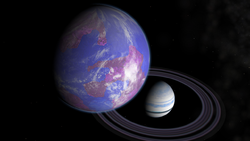Exomåne


En exomåne är ett begrepp som syftar på en mindre naturlig satellit, som kretsar kring en exoplanet eller annan massivare himlakropp. Ett viktigt motiv för intresset för exomånar är önskan att finna himlakroppar som är lämpliga för liv (se till exempel Billings 2013[1]). Många av de exoplaneter som man har upptäckt är stora gasjättar som liknar Jupiter. Dessa passar inte som värdar för liv som liknar vårt ens om de ligger i sina stjärnors beboeliga zoner. Däremot skulle deras eventuella månar vara mer passande för liv. För att en sådan måne ska kunna hålla sig med en atmosfär som liknar Jordens, skulle den behöva ha en massa som är minst en tiondedel av Jordens massa[2]. Det finns två scenarion för hur planeten skulle kunna få en sådan måne. Dels skulle den kunna bildas som resultatet av en kollision mellan planeten och en stor planetesimal. En annan möjlighet är att månen tidigare fanns i ett par av dvärgplaneter som är bundna till varandra, men att den blir infångad av gasjätten då dubbelplaneten passerar nära gasjätten.
Ännu har ingen exomåne kunnat observeras, men inget tyder på att sådanas förekomst skulle vara ovanlig. Redan kända extrasolära planeter är så stora att förhållandena i solsystemet antyder att flertalet borde ha månar.[3] Att upptäcka dem är en utmaning med dagens teknik.[4] Den mest lovande metoden är transitmetoden, då man detekterar en exoplanet genom dess regelbundna förmörkelser av sin stjärna. En stor exomåne kommer dels att ge små variationer i tidpunkterna för förmörkelserna eftersom planeten och månen båda roterar runt sitt gemensamma masscentrum, och dels kan djupet på förmörkelserna variera beroende på månens position relativt sin planet[5].
Se även
- Metoder för att upptäcka extrasolära planeter
- Transitmetoden
- Astrometri
- Fragmentskiva
Noter och referenser
- ^ Billings, Lee (2013). Five billion years of solitude
- ^ Billings, Lee (2014). ”The search for life on faraway moons”. Scientific American (January): sid. 38-43.
- ^ ”Skulle Pandora kunna finnas på riktigt?”. Populär Astronomi (1). 2010. https://www.popularastronomi.se/wp-content/uploads/2010/03/2010_1_avatar.pdf.
- ^ Kipping D. M. (2009). ”Transit timing effects due to an exomoon”. Monthly Notices of the Royal Astronomical Society 392 (3): sid. 181–189. doi:. https://arxiv.org/abs/0810.2243.
- ^ Kipping, D. M.; Bakos, G. A.; Buchhave, L.; Nesvorny, D.; Schmitt, A. (2012). ”The hunt for exomoons with Kepler (HEK). I. Description of a new observational project”. Astrophysical Journal 750: sid. 115. https://arxiv.org/abs/1201.0752.
Media som används på denna webbplats
Författare/Upphovsman: Frizaven on English Wikipedia (Originally uploaded on 19:09, 20 March 2006), Licens: GPL
A hypothetical rendition of the Blue Moon created by "Frizaven" on the 3D Space Simulator Celestia, Celestia is copyright free.
Artist's conception of the three suns and the newly discovered Jupiter-sized planet from the perspective of a hypothetical moon orbiting the planet. The large yellow sun is already halfway over the horizon. The orange and red suns are still visible in the sky. This artist's animation shows the view from a hypothetical moon in orbit around the first known planet to reside in a tight-knit triple-star system. HD 188753 Ab is a gas giant planet, about 1.14 times the mass of Jupiter, with an orbital period of 3.3 days discovered using the Keck I telescope atop Mauna Kea in Hawaii, and zips around a single star that is orbited by a nearby pair of pirouetting stars. Because the stars in this triple system are bunched together, sunsets on the planet -- or on any moons that might exist around the planet -- would be spectacular. This rambunctious stellar family is called HD 188753 and is located 149 light-years away in the constellation Cygnus.
In this movie, sunset is seen through the tenuous atmosphere of a hot, baked hypothetical moon. As the suns dip below the horizon, the gas giant comes into view. The moon's landscape remains illuminated by sunlight reflected off the planet. Both the planet and moon would be so hot that even in shadow their surfaces would glow.
The suns' colors and sizes reflect their masses, temperatures and distances to the planet. For example, the first star shown setting over the horizon is the closest, most massive and hottest of the trio, so it is depicted as large and white. The second star is farther away, less massive and cooler than the first, appearing smaller and yellow. The final star is at the same distance as the second, but it is still less massive and cooler, appearing even smaller and orange-red in color. Our Sun is a bit cooler than the hottest star of the system.
The graph in figure 1 shows the "wobble" of a star being tugged on by the planet called HD 188753 Ab. The planet was discovered via the radial velocity technique, in which a planet's presence is inferred by the motion, or wobble, it causes in its parent star. Stellar motion is plotted here as changes in velocity (y-axis) versus time (x-axis).
Unlike most planetary wobbles, this one comes from a star that is circled by a nearby pair of stars. In other words, the planet orbits a single star that is part of a close-knit triple-star system. Because the starlight from this cramped bunch blends together, the task of sifting through the light to find the planet's signature was more difficult. This challenge was overcome with the help of detailed models of the triple-star system's light. Data from those models resulted in precise velocity measurements of the star circled by HD 188753 Ab.
Note: The size of the Full-Res TIFF for the still image is 3200 samples x 2400 lines.
